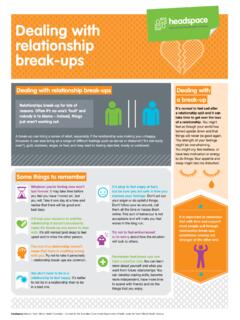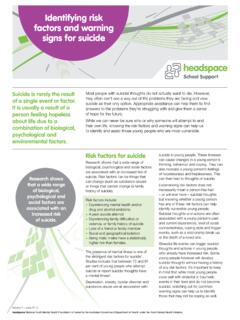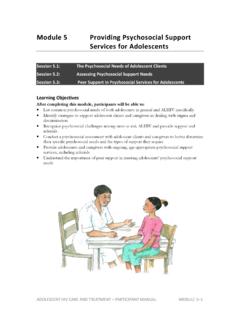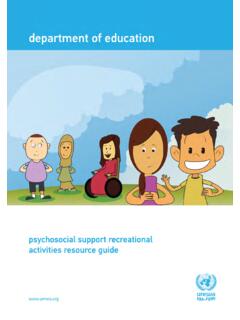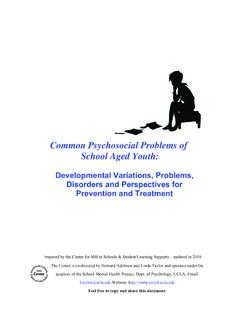Transcription of headspace Psychosocial Assessment 2013 V2
1 headspace Psychosocial Assessment for Young People The headspace Psychosocial Assessment guides the interviewer through a series of domains in order to assess areas of difficulty that may be indicative of Psychosocial problems An expansion of the HEADS Assessment Revised by the headspace Centre of Excellence: Parker, A. G., Hetrick, S. E., & Purcell, R. (2010). Assessment of mental health and substance use disorders in young people: Refining and evaluating a youth-friendly Assessment interview. Australian Family Physician, 39, 585-588. Original publication: Goldenring, J. M., & Rosen, D. S. (2004). Getting into adolescent heads: An essential update. Contemporary Pediatrics, 21, 64-90. Page 1 headspace Psychosocial Assessment Version Tips for engagement and interviewing The note an interviewer strikes at the outset may affect the entire outcome Introduce yourself to the young person first Ask the young person to introduce you to others who may be present This gives the young person a clear message that you are interested in him/her Don't begin the interview asking why are you here?
2 '. Chat with the young person about lighter, non-threatening topics Provide an outline of what's going to happen, including the range of questions Prepare them for the sensitive nature of some of the questions Let the young person know they can choose not to answer any of the questions Create an empathetic stance by acknowledging they may feel uncomfortable at times Build rapport so that the young person feels their concerns have been heard The young person should come away feeling that someone cares and that it might be useful to return Ask open-ended questions so that there is opportunity for rapport building and engagement The goal isn't just to elicit information about what might be wrong' with the young person Spend time during the interview asking for feedback Check that you understand the young person's main concerns and difficulties Clarify the young person's goal in coming to the Assessment Before concluding.
3 Ask if they have any questions or anything more to add Parents, family members, or other adults should not be present during the interview unless the young person specifically gives permission, or requests it The amount of time spent with the young person alone depends on his/her developmental age and stage The importance of the health practitioner's belief systems and assumptions Health care providers bring their own set of beliefs and assumptions about young people, based on their own knowledge and experience, which can result in varying levels of tolerance in dealing with particular situations, particularly health risk behaviours. It is essential to understand youth development and to be aware of the issues that young people might be facing. Young people are appropriately beginning to try out adult behaviours and gain increasing independence from parents and other adults.
4 Taking a respectful stance where young people are seen as responsible and able to make decisions will begin the process of building an effective collaboration between you and the client. It is important to ask questions in a non-judgmental way that does not imply assumptions, questions to young women about boyfriends' assumes heterosexuality, questions about mum and dad assumes a young person lives at home with two parents. If a health care provider is confronted with a situation that is challenging to them and causes a dilemma', it is suggested the health professional consult with a colleague or refer the young person for developmentally appropriate care. A youth focus will necessarily include listening carefully to their concerns and their goals in coming to see you, and ensuring their active participation in deciding on what to work on and how to work on it.
5 At the same time, young people are still developing and need support and reassurance. The level of their participation will depend on developmental age and stage. Page 2 headspace Psychosocial Assessment Version headspace Psychosocial interview domains The headspace interview covers 10 domains Home and Environment Education and Employment Activities Alcohol and Other Drugs Relationships and Sexuality Conduct difficulties and Risk-taking Anxiety Eating Depression and Suicide Psychosis and Mania PLUS final subsection: Summary (Strengths and Difficulties) and Goals Commence each domain with screening questions Are there concerns in response to the YES NO. screening questions? Proceed to elaborative/probing questions to Proceed to next headspace domain gain a more comprehensive understanding Use discretion in terms of how screening and probing questions are framed Given the age range of headspace clients (12-25), the young person's developmental stage needs to be taken into account For example, in the Drugs and Alcohol domain, ask a 12-15 year old if s/he drinks or uses drugs, whereas for a 16-25 year old, ask how often they use such substances Page 3 headspace Psychosocial Assessment Version Who should use the headspace Psychosocial Assessment ?
6 Any service provider within a headspace centre could use the headspace Psychosocial interview with a young person. It is designed to be used by any practitioner with experience conducting client assessments, including GPs, psychologists, social workers, occupational therapists, mental health nurses, youth workers, or substance use workers. The use of screening questions, as well as the progression from an Assessment of general functioning to mental health difficulties, allows the practitioner to be flexible with regard to the length and depth of their questioning. Nonetheless, the headspace Psychosocial interview does contain some sensitive items ( around the experience of abuse) as well as specific mental health content. Practitioners who do not feel confident to conduct the full interview with a young person should choose only to complete the screening questions (in those domains they feel competent to address), and to refer the young person to another experienced practitioner within the headspace centre for a full Assessment if indicated on the basis of their screening responses.
7 Similarly, a number of additional Assessment measures are recommended within several of the domains, if information additional to the probing questions is required ( the Suicide Risk screener). As these measures are recommended for even further elicitation of mental health difficulties, they should only be administered by GPs, psychiatrists or other mental health professionals, or services providers who are experienced with their use. The headspace Psychosocial interview provides a guide on how to ask questions of young people with mental health problems. Not all questions must be answered, nor do all questions need to be asked in the order suggested. The purpose is to commence with non-threatening questions in order to build rapport with the young person. However, if the young person initiates the interview with statements regarding their presenting problem, this can be explored initially before moving onto the other domains.
8 Finally, a summary of the issues discussed in the interview can be included at the end of the document, along with the goals the young person has in terms of what they would like to achieve from their engagement with headspace . Page 4 headspace Psychosocial Assessment Version Confidentiality Confidentiality is a major concern of young people. Many headspace clients may be concerned about what they say getting back to their parents, friends, or school teachers/ employers. It is therefore important that the extent of - and limits to - confidentiality are discussed from the outset of the Assessment , and revisited as necessary throughout any Assessment or treatment period with the young person. Confidentiality means that what is discussed with the young person is not repeated to others, unless it is deemed to be helpful and there is expressed permission from the young person.
9 The three main exceptions where it may be necessary to break confidentiality are when: 1) the young person is at risk of harming or killing themselves, 2) at risk of harming someone else or committing a serious criminal offence, or 3) they are being threatened or harmed (physical/sexual abuse) by someone else. Many health professionals may also be subject to Mandatory Reporting laws in suspected cases of child abuse and neglect (only mandatory for a young person under the age of 16). The professionals mandated to report vary across the different states and territories (see ). It may also be that disclosure is necessary in order to obtain information from other agencies or to engage other agencies in order to access services for the young person. In this case permission to disclose should be obtained in writing from the young person for non-urgent communications.
10 Important confidentiality considerations Confidentiality is essential to promote young people's access to health care, especially for sensitive concerns such as mental and sexual health, and substance abuse. A young person's right to confidentiality must be balanced with families' right to be informed. Confidentiality can be achieved whilst simultaneously encouraging the young person to share important information with their family, where appropriate. Involving the young person's family in treatment can contribute to better mental health outcomes. Clinicians should establish agreement concerning the extent to which information is to be shared with family and friends at the beginning of contact with a young person. In Australia, confidential health care is a legal right for competent adolescents. Competence is determined by clinical judgement of the young person's stage of development and their ability to understand what is being discussed, in the context of the relevant local and national legislation.



